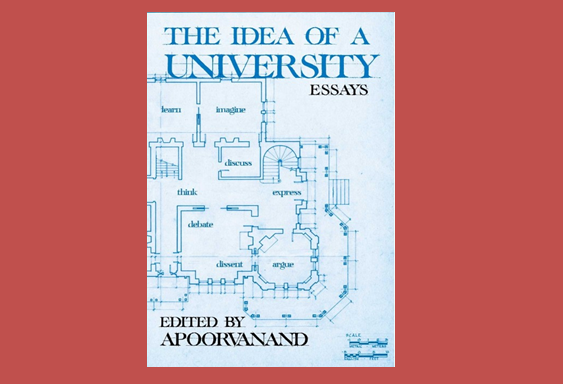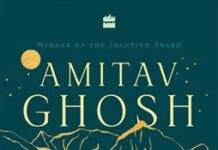BOOK REVIEW

‘Utopias are sweet dreams’, wrote Kant, but to strive relentlessly towards them is the duty of the citizen and of the statesmen as well. Universities must stand for these ideal causes which can never be lost so long as men seek wisdom and follow righteousness.
– S. Radhakrishnan
Apoorvanand is a leading public intellectual. A careful reader of his works is familiar with his sensitivity to literature, culture and politics. And at this crucial juncture of our political history, we have witnessed his academic/intellectual activism; and, needless to add, he has aroused diverse emotions amongst his readers.
I too follow his writings. However, this time as an ordinary teacher, what has aroused my interest is the volume on the ‘idea of a university’ he has edited. A book of this kind acquires its relevance precisely because higher education is in crisis; and it is, therefore, important to look at our universities – the dynamics of the state and the market in the management of education, the politics of the production and dissemination of knowledge, and the possibility of critical thinking amid the dominant ideology and resulatant violence in our public life. Furthermore, the fact that it has been edited by Apoorvanand known for his sharp critique of the ruling regime, and some of the contributors are pretty well-known for their anti-establishment perspectives is yet another reason why the book has already acquired great attention.
However, I was not in a hurry. As a teacher, I have always cherished the art of doing things in silence. I follow my own rhythm. And now as I borrow the book from a student of mine, I begin to read it. Believe me, I am praying: let it be an experience of inner churning and pedagogic inspiration, not merely an engagement with yet another manifesto of ‘political correctness’.
Where is the Unconditional Joy of Learning?
Yes, I am resisting the temptation of beginning with Apoorvanand’s introductory note. The reason is that I am often fascinated by not so ‘visible’ figures. Hence,, an ‘early career professional’ arouses my attention. As a teacher engaged in the field for quite some time, I wish to know what Irfanullah Farooqi thinks as a young scholar/thinker. Let me quote a paragraph from the piece he has written:
Within the academia, the primacy of the written word remains incontestable. While there is something distinctly vital about academic publications in terms of dissemination of ideas and democratisation of knowledge, what also merits our attention is that it is not what it used to be several decades ago. Thanks to its indispensability in relation to promotion, these days it is a means to an end rather than an end in itself. In that respect, the ways in which API has corrupted our academic landscape needs no mentioning. Academic prose is neither created passionately nor read willingly. Writing has ceased to be an art and instead has become more of a tactics; substandard publications have acquired a disturbing normalcy, and, in relation to renowned journals, elite networks have come into being that prefer a specific ideological bent.
I agree with Farooqi. He is honest and perceptive. And he is courageous. We ought to reflect on this pathology; it is beyond the ‘left’/’right’ dichotomy. No matter whether one adheres to Marxism, postcolonialism, Ambedkarism or Savarkarism, it seems to have affected all of us. We are losing the soul of the university or the beauty of teaching because of this compulsive urge to publish–and at times, meaninglessly, and make our presence felt through the subtle game of networking. Yes, as an insider, I know that even the ‘progressive’ lot in the academia do it quite smartly.
I am happy that as a young teacher he could see it so clearly. His sensitivity arouses hope. He is right in pointing out that ‘the market-driven system has not prepared us to find meaning in silent accomplishments’; instead because of the ‘stress on measurable performance’, there is no appreciation for a teacher who facilitates her students’ lifelong engagement with ideas.’ If good teachers disappear from our classrooms, the university cannot be saved even if one feels proud of ‘publications’ and ‘citation index’.
Likewise, Shiv Visvanathan’s piece touches me. In this age of ‘utility’ and ‘productivity’, it is great to find someone who pleads for the ‘playful quality’ of knowledge. Hence, when he speaks of ‘academic freedom’, he reminds us of the need to resist the instrumentalisation/ideologisation/economisation/bowdlerisation’ of knowledge. Yes, creativity has to allow for what Visvanathan regards as ‘idle curiosity’. It is a powerful observation. These days we are often pressurized to measure the ‘relevance’ of a branch of knowledge in terms of the market rationality. This is dangerous. If we truly strive for academic freedom, we ought to realize that ‘definitions of relevance have to be open-ended rather than client-centric’. Possibly, the paper would have acquired a new meaning, had he reflected (I mean honest reflection) on his own experience as a celebrity faculty in a ‘private university’.
It is in this context that I find Saumen Chattopadhyay’s paper quite meaningful. He sees clearly what the the discourse of neo-liberalism has done to academic freedom. As the market invades the sites of higher education, ‘the customisation of the course content for the purpose of raising employability of graduates’ tends to become the new normal. Yes, ‘self-financed’ courses become popular, and in the market-driven ethos of neo-liberalism, students find themselves as consumers. See its devastating consequence. Let me quote from Chattopadhyay’s paper:
In a typical private institution, responding to the market when the students are unfortunately treated as consumers, academic freedom is compromised in various ways to appease students, starting from fake inflation of attendance to grade inflation. This happens because students show their keenness for certificates at the expense of learning and they are the sources of revenue which are required to sustain the functioning of the college.
The traces of this anxiety can also be seen in Francesca Orsini’s paper. She experiences it as a professor of Hindi and South Asian literature at the School of Oriental and African Studies, London. The ‘management discourse’ –the interplay of ‘market forces, excellence and sustainability’–seeks to process and filter the contents of knowledge. Yes, ‘it rewards certain topics and discourages others by not funding them’. It is like directing students to ‘subjects and disciplines that promise to offset the enormous debts that they now incur in order to obtain a university education in the first place’. It is a kind of ‘academic unfreedom’. Because, as Orsini articulates with intense anguish, it makes the process of teaching and learning languages ‘unsustainable’. The question that haunts us is whether it is possible to cultivate a culture of learning that ‘subverts the market-oriented goals and research’.
Anguish, Despair and Reflexivity
Reading this book is also like feeling the anguish expressed by many contributors. It is their sharp critique of the onslaught on public universities: the way the ruling regime suspects and stigmatizes the voices of dissent and critical thinking. I understand why Kalpana Kannabiran feels so strongly that dissent, which lies at the core of even a ‘minimalist idea of academic freedom’, is in this new era constructed as ‘incitement to violence’ and a ‘threat to national security’. Yes, the’ barbarians’, as Alok Rai feels, seem to have landed. This makes us understand the meaning of the attack on public universities. I feel tempted to quote from Rai’s politically nuanced literary essay:
In our own more melancholy times, we must rephrase Kipling and ask: ‘What does if the university dies?’ because what is at stake now is not meely a bunch of students – Kanhaiya, Shehla, Umar–nor particular departments – History… What is at stake is the very possibility of a university, of free enquiry itself.
J.Devika’s brief essay – filled with the power of passion and persuation – looks at academic freedom from a ‘no person’s land’. While she deeply mourns the damage that the recent attacks have inflicted on a university like JNU, she also reminds us (possibly, because of her own experience at the Centre for Development Studies in Kerala) that if the idea of academic freedom is imposed from above, it is bound to have its severe limitations.
Yes, as a reader , I feel like reading the essays written by some of the leading social scientists – Nirja Gopal Jayal, Mary E.John, Mohammad Sajjad and Nandini Sunder. Yes, this experience is enriching. Informative, argumentative and conceptually enriched–the essays help me to go deeper into the idea of academic freedom, the internal struggles within the university, and the need for constant reflection. In fact, the reflexive quest that I see in Sajjad’s essay has appealed to me. He speaks of the ‘huge disjunctions between the ivory towers of academics and the rest of society comprising the toiling millions’. Yes, we must resist the onslaught on academic freedom. However, we should not forget to look at our own deeds and practices. Let me quote from Sajjad’s essay:
Let us confess, rather candidly, that our universities have failed to sensitise our youth adequately. We did not warn our hedonist middle classes about their lack of ideological moorings and their passionate consumerist ambitions. These inequalities, and the lack of concern for the disadvantaged, started becoming even starker within the campuses. In fact, the problem went even further. There developed a fear, and hatred, against the upward mobility of the hitherto dispossessed–be it the Dalits, the tribes, OBCs or religious minorities.
Is It Unreasonable to Expect Something More?
It is not always easy to read an edited volume. I know that these days, because of the performance anxiety, it is becoming increasingly difficult for a scholar to write a coherent manuscript. It takes time, and possibly a high degree of patience. No wonder, we live amid the proliferation of edited volumes. Organize a seminar, collect the papers, write an introductory note, manage a publisher, and come forward with a book. Quite often, it is an enterprise.
Well, it would be wrong on my part to deny that in some of these edited volumes–including the one I am reviewing, I have found many good papers. Yet, I miss something. A collection of diverse forms of writing and diverse themes tends to make the mind somewhat burdened. I experience the absence of a rhythm–the joy of undertaking a single author’s journey through the well-connected chapters. For instance, is it easy to find the thread of connectedness when you read all the eighteen papers in the volume? Does Payel Chattopadhyay Mukherjee’s rigorous analysis of Newman, Humboldt and Tagore relate to Vinay K.Kantha’s plea for ‘freedom as intellectual necessity’? Or for that matter, it is not easy to understand whether Debaditya Bhattacharya and Quentin Thompson are truly conversing with each other. No, the editor of the volume has not helped a reader like me to get an answer to this question.
Yet, I try my best, and seek to learn from, say, the insightful essays of Shobhit Mahajan, Ram Ramaswamy and Pankaj Chandra. But then, I must add that as an editor Apoorvanand has not done his job properly. Well, I have enjoyed his introductory note–its style, its mode of narration and, its way of seeing the art of possibility in a university–say, the flowering of a relationship between a Brahmin girl and a tribal boy. In an age obsessed with ‘ranking’ , ‘placement’ and ‘salary package’, It is really refreshing to find a scholar like Apoorvanand who can whisper in our ears, and tell a different story:
It is unfair, as some have done, to call the years spent on a campus as ‘time pass’ for youngsters. The campus gives them breathing space, away from the stifling atmosphere back in their villages or small towns, which are still bound by community or caste norms. In a highly hierarchical and divided society like India, universities are the only spaces where young men and women can find occasions, and the confidence, to break social barriers.
But then, my complain is that he could have evolved a rationale for choosing the kind of papers he has included in the volume. He could have placed the papers in logically thought out sub-sections with a brief explanatory note for each section. Not solely that. Where is his own essay in the volume? With my heightened empathy, I can understand that because of his intense engagement, socio-political activism and tight schedule, he could not do it. But he should have done it, even if the publisher has assured him that in this age of ‘brand consciousness’, his ‘name’ matters, and hence he need not bother about all these ‘minor’ issues!
Yes, it is a reasonably good volume. However,it could have been better.
Apoorvanand (ed.), The Idea of a University, Context, Chennai, 2018, pp.272, price Rs. 699.














